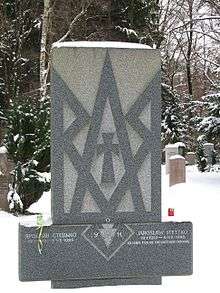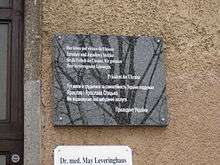Yaroslav Stetsko
| Yaroslav Stetsko Ярослав Стецько | |
|---|---|
|
Yaroslav Stetsko | |
| Leader of the OUN-B | |
|
In office 1968–1986 | |
| Personal details | |
| Born |
19 January 1912 Ternopil, Austria–Hungary |
| Died |
5 July 1986 (aged 74) Munich, Germany |
| Nationality | Ukrainian |
| Political party | OUN-B |
| Spouse(s) | Yaroslava Stetsko |
| Occupation | Politician |
| Religion | Ukrainian Greek Catholic Church |
Yaroslav Stetsko (Ukrainian: Ярослав Стецько; 19 January 1912 – 5 July 1986) was the leader of Stepan Bandera's Organization of Ukrainian Nationalists (OUN), from 1968 until his death. In 1941, during the Nazi German invasion of the Soviet Union, he was self-proclaimed temporary head of the ostensibly independent Ukrainian government declared by Stepan Bandera. Stetsko was the head of the Anti-Bolshevik Bloc of Nations from the time of its foundation until 1986, the year of his death.
Biography
Childhood
Yaroslav Stetsko was born on 19 January 1912 in Ternopil, Austria–Hungary (now Ukraine) into a Ukrainian Catholic priest's family.[1] His father, Semen, and his mother, Teodoziya, née Chubaty, encouraged him to pursue a higher education, which was very difficult for ethnic Ukrainians. Yaroslav not only graduated high school in Ternopil, but later studied law and philosophy at the Kraków and Lwów Universities, graduating in 1934.[2]
Youth activities
Yaroslav Stetsko was active in Ukrainian nationalist organizations from an early age. He was a member of three separate organizations: "Ukrayinska Natsionalistychna Molod'" (Ukrainian Nationalist Youth; Ukrainian: Українська Націоналістична Молодь) where he became a member of the National Executive in 1932, Ukrainian Military Organization (UVO) (Ukrainian: Українська Військова Організація) and eventually the Organization of Ukrainian Nationalists (OUN) (Ukrainian: Організація Українських Націоналістів).
Because of his anti-Polish activities and the recent assassination of Bronislaw Piernacki by Ukrainian nationalists, Stetsko was arrested by Polish authorities in 1934 and sentenced to a 5-year term.[2] This sentence was reduced, and Stetsko was released in 1937 in a general amnesty.
World War II
The Nazis and the OUN
According to the National Academy of Sciences of Ukraine and other sources, OUN leaders had meetings with the heads of Nazi Germany's intelligence, regarding the formation of "Nachtigall" and "Roland" Battalions. In spring the OUN received 2.5 million marks for subversive activities inside the USSR.[3][4]
Operation Barbarossa
On 30 June 1941, Stetsko declared in Lviv the formation of a Ukrainian state which "will closely cooperate with the National-Socialist Greater Germany, under the leadership of its leader Adolf Hitler which is forming a new order in Europe and the world" – as stated in the text of the "Act of Proclamation of Ukrainian Statehood"[4] Gestapo and Abwehr officials protected Bandera followers, as both organizations intended to use them for their own purposes.[5]
On 5 July, OUN-B leader Bandera was placed under honorary arrest (Latin: custodia honesta) in Kraków, and transported to Berlin the next day. On 14 July he was released, but required to stay in Berlin. On 12 July 1941 he was joined in Berlin by his deputy Yaroslav Stetsko, whom the Germans had moved from Lviv after an unsuccessful attempt by unknown persons to assassinate him.[6] During July–August both of them submitted dozens of proposals for cooperation to different Nazi institutions (OKW, RSHA etc.) and freely communicate with their followers. [7] After the assassination of two key members of the Melnyk OUN, said to have been carried out by members of the OUN-B, Bandera and Stetsko were held in the central Berlin prison at Spandau from 15 September 1941 until January 1942, when they were transferred to Sachsenhausen concentration camp's special barrack for high-profile political prisoners, Zellenbau.[8]
In April 1944 Stepan Bandera and his deputy Yaroslav Stetsko were approached by Otto Skorzeny to discuss plans for diversions and sabotage against the Soviet Army.[9]
In September 1944 Stetsko and Stepan Bandera were released by the German authorities in the hope that he would rouse the native populace to fight the advancing Soviet Army. With German consent, Bandera set up headquarters in Berlin.[10] The Germans supplied the OUN-B and the UIA by air with arms and equipment. Assigned German personnel and agents trained to conduct terrorist and intelligence activities behind Soviet lines, as well as some OUN-B leaders, were also transported by air until early 1945.[11][9]
In April 1945 Stetsko was seriously injured during an Allied air-attack on a Nazi military convoy in Bohemia.[12]
Antisemitism
In August 1941 Stetsko wrote his autobiography. It was addressed to the German authorities, and contained several notable antisemitic passages; in particular he stated that he considered Marxism a product of Jewish thought, that was put into practice by the Muscovite-Asiatic people with Jewish assistance, and that Moscow and the Jews are the carriers of the international ideas of the Bolsheviks. He stated that although he considered Moscow rather than the Jews to be the main enemy of imprisoned Ukraine, he absolutely endorsed the idea of the indubitably harmful role of Jews in the enslavement of Ukraine by Moscow. He finally stated that he absolutely endorsed the extermination of the Jews, and the rationality of the German methods of extermination of Jews, instead of assimilating them.[13][14][15][16][17]
After the war
Stetsko continued to be very active politically after World War II. In 1968 he became the supreme leader of the OUN-B. He also became a board member of the World Anti-Communist League.
The Anti-Bolshevik Bloc of Nations
In 1946, Stetsko spearheaded the creation of a new anti-Soviet organization, the Anti-Bolshevik Bloc of Nations (ABN). He was president of this organization until his death.[18]

Death

On 5 July 1986, Yaroslav Stetsko died in Munich, Germany. He was 74 years old. Stetsko was buried in the Munich Waldfriedhof.
Legacy
Stetsko's book "Two Revolutions" (1951) is the ideological cornerstone of the political party All-Ukrainian Union "Svoboda".[19][20] The essence of this doctrine is: "the revolution will not end with the establishment of the Ukrainian state, but will go on to establish equal opportunities for all people to create and share material and spiritual values and in this respect the national revolution is also a social one".[19]
In 2010, at the initiative of Viktor Yushchenko, a plaque for Yaroslav Stetsko was mounted at his home in Zeppelinstraße 67 in Munich.[21]
References
- ↑ John Armstrong (1963). Ukrainian Nationalism. New York: Columbia University Press, pg. 54
- 1 2
- ↑ "Організація українських націоналістів і Українська повстанська армія. Інститут історії НАН України.2004р Організація українських націоналістів і Українська повстанська армія" (PDF). History.org.uk. p. 1.(Archived 2 December 2012 at the Wayback Machine.)
- 1 2 І.К. Патриляк. Військова діяльність ОУН(Б) у 1940—1942 роках. – Університет імені Шевченко \Ін-т історії України НАН України Київ, 2004 (No ISBN)
- ↑ p.15 ОУН в 1941 році: документи: В 2-х ч Ін-т історії України НАН України К. 2006 ISBN 966-02-2535-0 – У владних структурах рейху знайшлися сили яки з прагматичних міркувань стали на захист бандерівців. Керівники гестапо сподівалися використовувати їх у власних цілях а керівники абверу а радянському тилу.
- ↑ Після проголошення держави й уряду наложили на нього дня 5.7. почесний арешт (Еренгафт) та перевезли його до Берліна. Дня 14.7 провідника організації звільнено із забороною опускати Берлін. p.420 ОУН в 1941 році: документи: В 2-х ч Ін-т історії України НАН України К. 2006 ISBN 966-02-2535-0
- ↑ p.16 Голова уряду Я.Стецько майже до кінця серпня вільно проживав у Берліні і закидав посланнями відомства Розенберга, Ріббентропа,Гіммлера і Кейтеля) ОУН в 1941 році: документи: В 2-х ч Ін-т історії України НАН України К. 2006 ISBN 966-02-2535-0
- ↑ Berkhoff, K.C. and M. Carynnyk 'The Organization of Ukrainian Nationalists and Its Attitude toward Germans and Jews: Iaroslav Stets'ko's 1941 Zhyttiepys' in: Harvard Ukrainian Studies, vol. 23 (1999), nr. 3/4, pp. 149—184 .
- 1 2 D.Vyedeneyev; O.Lysenko (2009). "Завдання підривної діяльності проти Червоної армії обговорювалося на нараді під Берліном у квітні того ж року (1944) між керівником таємних операцій вермахту О.Скорцені й лідерами українських націоналістів С.бандерою та Я.Стецьком»" (PDF). Ukrainian Historical Magazine. 3: 137.
OUN and foreign intelligence services 1920s–1950s
(Archived 2 March 2012 at the Wayback Machine.) - ↑ "West Germany: The Partisan," Time magazine (Monday, 2 November 1959).
- ↑ Organization of Ukrainian Nationalists and the Ukrainian Insurgent Army, p.338 (Archived 25 March 2009 at the Wayback Machine.)
- ↑ Вєдєнєєв Д. Проблеми історії України: факти, судження, пошуки. – Київ: Інститут історії України НАН України, 2003. – №10. ISSN 0869-2556 – page .405
- ↑ ""Тому я підтримую знищення жидів та доцільність впровадження німецьких методів винищення жидівства в Україні, а не лише їхню асиміляцію і тому подібне"". Istpravada.com.au (in (Ukrainian)). Retrieved 2016-08-21.
- ↑ John A. Armstrong, Ukrainian Nationalism, 2nd ed. (Littleton, CO.: Ukrainian Academic Press, 1980) 77–84.
- ↑ (Ukrainian) Orest Dzuban "Українське державотворення. Акт 30 червня 1931. Збірник документів і матеріалів" (Львів-Київ: Піраміда, 2001) p.153
- ↑ (Ukrainian) "Події на західноукраїнських землях (інтерв’ю з доцентом др. Г.І.Байєром)", Краківські вісті, 6 липня 1941.
- ↑ Karel C. Berkhoff, Marco Carynnyk (1999). The Organization of Ukrainian Nationalists and Its Attitude toward Germans and Jews. Harvard Ukrainian Studies. p. 171.
- ↑ Stetsko, Yaroslav, in: Encyclopedia of Ukraine. Volume 5. St - Z. Toronto: University of Toronto Press, 1993, p.55
- 1 2 Mridula Ghosh (October 2012). "The Extreme Right in Ukraine" (PDF). Library.fes.de. Retrieved 2016-08-21.
- ↑ Україна. "Історія ВО "Свобода"". Svoboda.org.ua. Retrieved 2016-08-21.
- ↑ "Gedenktafel für Nazi-Kollaborateur und Antisemiten – wer ist verantwortlich?" (PDF). Ris-muenchen.de (in (German)). Retrieved 2016-08-21.
